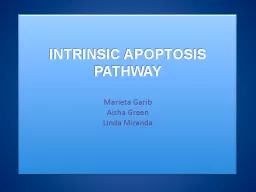

Marieta Garib Aisha Green Linda Miranda WHAT IS INTRINSIC APOPTOSIS AND WHY DO WE CARE Programmed celldeath involving permeability of mitchondria Involves Caspase9 As opposed to extrinsic ID: 913603
Download Presentation The PPT/PDF document "INTRINSIC APOPTOSIS PATHWAY" is the property of its rightful owner. Permission is granted to download and print the materials on this web site for personal, non-commercial use only, and to display it on your personal computer provided you do not modify the materials and that you retain all copyright notices contained in the materials. By downloading content from our website, you accept the terms of this agreement.
Slide1
INTRINSIC APOPTOSIS PATHWAY
Marieta
Garib
Aisha Green
Linda Miranda
Slide2WHAT IS INTRINSIC APOPTOSIS AND WHY DO WE CARE?
Programmed cell-death involving permeability of
mitchondria
.
Involves Caspase-9
As opposed to extrinsic.
Tumor necrosis factor
Caspase-8
No mitochondria
Slide3WHAT IS INTRINSIC APOPTOSIS AND WHY DO WE CARE?
Intrinsic pathway induced by chemotherapeutic agents.
Activation or
downregulation
of apoptosis influence cancer cell viability.
Slide4http://www.qiagen.com/GeneGlobe/Pathways/Mitochondrial%20Apoptosis.jpg
Slide5Slide6Slide7Caspase
3 Activation = 377.940 seconds
1 Molecule = 477.740 seconds
Slide8Activation = 394.350 seconds
.99 Caspase-3 = 477.740 seconds
Slide9Activation = 306.390 seconds
.98 molecule Caspase-3 = 484.900
Slide10Slide11Caspase-3 is activated at 250.250 sec.
1 molecule 499.490 sec.
Slide12Activation = 239.044
secs
1 molecule = 490.759
secs
Slide13Activation = 229.350
secs
1 molecule = 497.330
secs
Slide14Active
holoenzyme
at 177.137 seconds.
1 molecule of Caspase-3 at 415.351 seconds
Slide15Slide16Problems and Issues
choice between intrinsic and extrinsic
pathways
finding a target molecule to
test
complexity of the chemical reactions and
large
number of molecules observed
Slide17Problems and Issues
difficulty with ODE
simulation
long running time of the program due to the complexity of the reactions and the large number of molecules
examined
long
t_end
=>500
to produce
results
very long
.
gdat
files
Slide18CONCLUSIONS
Varying the concentrations of ATP affects the formation of the
holoenzyme
Higher = faster activation of Caspase-3
Lower = longer activation time
Slide19FUTURE EXPERIMENTS
Vary concentrations of Apaf-1 and
Cytochrome
C
Will they affect
holoenzyme
formation?